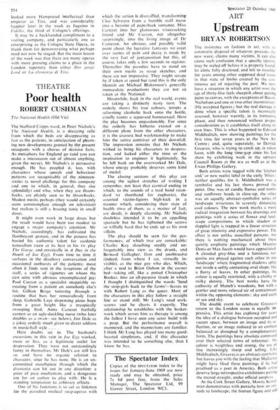ART
Upstream
BRYAN ROBERTSON
The insistence on fashion in art, with its automatic disposal of whatever precedes the
new wave, claims many victims. It can also cause such confusion that a specific identity may be sealed off before it is properly found, let alone fully disclosed, and left to moulder for years among other supposed dead issues in that state of limbo created by the con- tinuous act of rejecting the past. We now have a situation in which any artist over the age of thirty-five feels sheepish about putting paint to canvas, with the exceptions of Bacon. Nicholson and one or two other incontrovert- ibly' accepted figures ; but the real damage is done when a specific talent is incorrectly assessed, however warmly, in its formative phase, and then renounced without proper consideration as it establishes itself alone its own lines. This is what happened to Edward Middleditch, now showing paintings for the first time for seven years at the New Art Centre ; and, quite separately, to Derrick Greaves, who is trying to catch up, in token form, with the long time-gap since his last show by exhibiting work in the upstairs Council Room at the ICA as well as at the Ewan Phillips Gallery.
Both artists were tagged with the- 'kitchen sink' or new realist label in the early 'fifties ; neither qualifies for it. Middleditch was a symbolist and his last shows proved the point. One was of candle flames and moths and sunflower heads in close-up, the other was an equally abstract-symbolist series of landscape structures in severely distancing cool colours. The new work marks a more radical integration between his drawings and paintings with a series of flower and land- scape compositions in which shadow or dappled light is trapped in-a linear structure of great intensity and expressive power. The effect is not unlike stencilled patterns, but there. is nothing mechanical about these quietly emphatic paintings which Maurice Denis or Max Jacob would have appreciated. A clouded grey-blue and a luminous tur- quoise are played against each other in one 'landscape' where fragmented shadows splay out inside a softly containing oval shape, like a flurry of leaves. In other paintings, the colour is equally restricted, with a chalky or milky density. The best works have the authority of Munch's woodcuts, but with a gentler and more relaxed air of containment within the opposing elements: sky and earth or sea and sky.
The double event to celebrate Greaves's return to the London scene is equally im- pressive. This artist has explored for years the idea of a dialogue between occupied and vacant space, between an image and its re- flection, or an image reduced to an emblem balanced or disrupted by a complementary form. The paintings have absolute command over their selected terms of reference : the colour is weightless and strong, the use ot line increasingly sharp and telling. Like Middleditch, G reeves is an abstract-symbolist but leaves you with the feeling that Mallarme might have liked these paintings if he had practised as a poet in America. Both artists deserve large retrospective exhibitions putting the record straight, under official auspices. At the Cork Street Gallery, Morris Kestel- man demonstrates with panache how an atti- tude to landscape, the human figure and still
life can generate enough energy to find its 3wn abstract expression by developing for- mal and harmonic concepts from his earliest atle.iances: the school of Paris. Kestelman is a continental painter who has also stuclc. it out against the steam roller of fashion, as II as the limitations of English taste. By bale true to his own sensibility, and by re- sisting the allure of more fashionably acceptable escape routes, his paintings have .1 rock-like integrity : their glowing colour t.tkes on a still richer depth.
The AIA gallery in Lisle Street has assembled a lively and well-timed group of small pictures, to show that a painting does not necessarily have to occupy an entire wall : Peter Simpson, Joyce Battey, and Peter Wil- liams shine in a gathering whose modesty is confined only to scale. The social purposes of the Artists International Association, and particularly its political stand in the 'thirties, might have found favour with John Heart- field whose fiercely resourceful photo- montages are now exhibited at the IcA. This is a disturbing show, of absolute uthentieity, and will doubtless provide food or thought to a younger generation for whom socio-political comment is aesthetic eresy, unless restricted to the nursery of the impler and more tasteful/tasteless emblems f popular culture. Pop guns had no charm or Heartfietd: he was up against bayonets nd the gas chambers.



















































 Previous page
Previous page